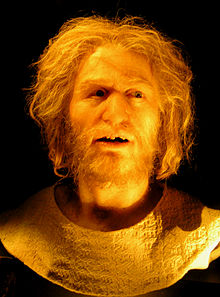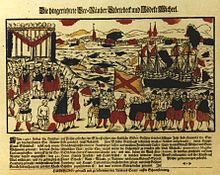Klaus Störtebeker
This article needs additional citations for verification. (January 2013) |
Störtebeker | |
|---|---|
 Reconstruction of head from skull ascribed to Störtebeker | |
| Born | 1360 |
| Died | assumed 20 October 1401 (aged 40–41) assumed Hamburg |
| Cause of death | execution by beheading |
| Other names | Storzenbecher |
| Occupation(s) | merchant, privateer, violent entrepreneur |
| Years active | assumed 1392–1401 |



"Nikolaus" Storzenbecher or "Klaus" Störtebeker (1360 – supposed 20 October 1401) was reputed to be leader of a group of
Biography
A large number of myths and legends surround the few facts known about Störtebeker's life. His name is both a nickname and a surname, meaning "empty the mug with one gulp" in
Born in the Baltic port of
Störtebeker had a stronghold in
Legend
According to legend, in 1401, a
According to other legends, when Störtebeker's ship was found, the masts contained a core of gold (one of gold, one of silver, and one of copper). This was used to create the tip of St. Catherine's church in Hamburg. His famous drinking cup was stored in the town hall of Hamburg, until it was destroyed in the great fire of 1842.[7]
Recent events have suggested it is more likely that Störtebeker and his crew died in 1400. A bill for digging graves for 30 Victual Brothers dated to this year survives in the Hamburg records. This would also suggest the story that Störtebeker was sentenced to death with 70 other privateers is at least misleading; at minimum, he certainly was buried with 30 other men. The year 1400 also excludes the involvement of Simon of Utrecht and the ship Bunte Kuh ("Colorful Cow"), since the records show the ship was not completed until 1401. In fact, the Hanseatic fleet that attacked Störtebeker was commanded by Hermann Langhe (also Lange) and Nikolaus Schoke (Nicoalus Schocke), who set sail for Heligoland in August 1400, and the course of the battle is not described by any reliable sources.[8]
Appearance
No authentic portrait of Störtebeker is known. An etching made by Fifteenth century German artist
Memorials and legacy
- Statues depicting him stand in a number of Northern German cities, including Hamburg, Verden an der Aller and Marienhafe.[11]
- Störtebeker Festival (Störtebeker Festspiele) is an open-air theatre event, held annually in the town of Ralswiek on the isle of Rügen.[12]
- The term Stoertebekerland has been adopted to promote tourism in East Frisia[13]
Novels, TV, and beer
Störtebeker is mentioned in several Apothecer Melchior books by Estonian writer Indreg Hargla
Stortebeker is the name of the leader of the youth gang The Dusters in the novel
The character of Klaus Störtebeker has appeared in various recent publications including Die Vitalienbrüder: Ein Störtebeker Roman. a German language novel by
Störtebeker was portrayed on television by Ken Duken in Störtebeker, a 2006 miniseries. He was also the subject of a 2007 documentary and of the feature-length movie 12 Paces Without a Head, in the making in 2008.[14][15]
The German brewery Störtebeker Braumanufaktur chose their name as a homage to Störtebeker.
References
- ^ Piraten in Norddeutschland (Birgit Bachmann und Stefan R. Müller) Archived 2013-02-10 at archive.today
- ^ Hamburger Abendblatt about research and an exhibition questioning the identity
- ^ Die Vitalienbrüder, eine Freie Kompanie im Ostseeraum (kriegsreisende.de)
- ^ Störtebekerturm (Störtebeker Tower)
- ^ Turmmuseum im Störtebekerturm. Ostfriesland Tourismus
- ^ Klaus Störtebeker (stoertebekers-teestube.de)
- ^ "The big fire - Hamburg 1842 (ksfhh.de)". Archived from the original on 2016-03-04. Retrieved 2015-03-11.
- ISBN 978-3-593-34525-3.
- ^ "Hamburg Searching for Plundered Pirate Skull". Spiegel Online International. January 21, 2010. Retrieved 2010-01-21.
- ^ "Polizei stellt gestohlenen Störtebeker-Schädel sicher". Hamburger Abendblatt. March 17, 2011.
- ^ "Das Störtebeker-Denkmal in Marienhafe (Touristinformation Brookmerland)". Archived from the original on 2016-03-24. Retrieved 2015-03-11.
- ^ "Störtebeker Freilichtspiele (Touristinformation Brookmerland)". Archived from the original on 2017-09-14. Retrieved 2015-03-11.
- ^ Stoertebekerland Official Website
- ^ Störtebeker (moviepilot)
- ^ Nicholas Kulish (November 6, 2008). "Germans revive a legendary pirate". NY Times.
Other sources
- Bents, Harm (2003). Störtebeker. Dichtung und Wahrheit [Störtebeker: fiction and truth] (in German). SKN Druck und Verlag Norden. ISBN 978-3-928327-69-5.
- Lornsen, Boy (2005). Klaus Störtebeker: Gottes Freund und aller Welt Feind [Klaus Störtebeker: Friend of God and enemy of the world] (in German). Carlsen Verlag GmbH. ISBN 978-3-551-35447-1.
- Puhle, Matthias (1992). Die Vitalienbruder: Klaus Stortebeker und die Seeräuber der Hansezeit [The Victual Brothers: Klaus Störtebeker and the pirates of the Hanseatic period] (in German). Campus Verlag. ISBN 978-3-593-34525-3.
- Püschel, Klaus; Wiechmann, Ralf; Bräuer, Günter, eds. (2003). Klaus Störtebeker: Ein Mythos wird entschlüsselt [Klaus Störtebeker: A legend deciphered] (in German). Munich: Wilhelm Fink. ISBN 978-3-7705-3837-9.[1]
External links
 Media related to Klaus Störtebeker at Wikimedia Commons
Media related to Klaus Störtebeker at Wikimedia Commons- Die Störtebeker Story (Hambury de)
- Offizieller Webauftritt der Störtebeker Festspiele
- Die Likedeeler, Klaus Störtebeker und Godeke Michels (kriegsreisende.de)
- JSTOR 29542662.

